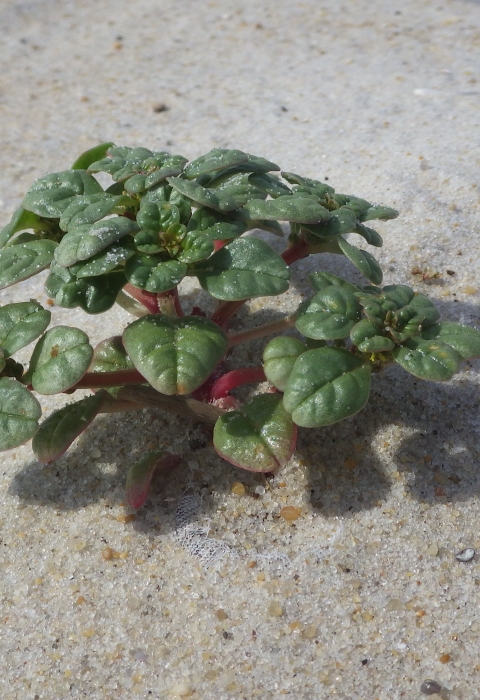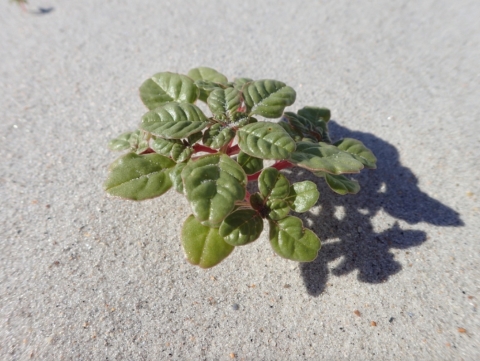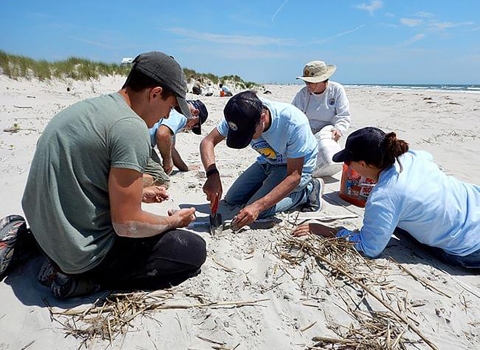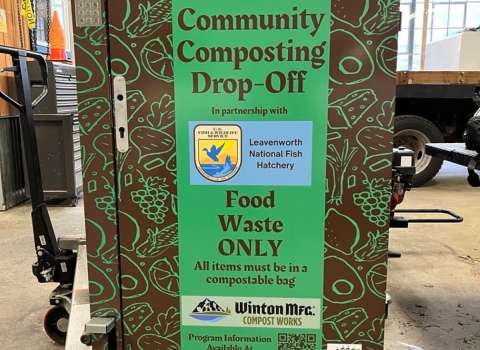After a strong coastal storm displaces much of the wildlife, one brave species returns to the beach.
It builds up the sand into magnificent dunes.
It uses its body to shield other creatures from the elements.
And it does all this while eating nothing but sunlight.🌱☀️
But sometimes even the most intrepid species need our help.
Sand-trapping pioneer
Seabeach amaranth is a short, green-leafed plant with ruby-red stems that grows annually on sparsely vegetated ocean beaches. This pioneer plant — one of the first to grow back after disturbances like natural disasters — traps sand, initiating dune formation and providing shelter to shorebirds.
But this hospitable plant faces threats from coastal development, beach stabilization projects, beach driving and foot traffic, competition with other plant species, and sea-level rise. In 1993, this plant was listed as threatened under the Endangered Species Act to protect it from further declines.
Fortunately, the Service and our partners have nurtured a thriving population that shines as a beacon of hope for the future of the species.
In it together
Seabeach amaranth was revitalized using the ecosystem approach. Rather than focusing only on what’s best for the species, biologists with our Long Island and New York Ecological Services field offices looked at the beaches it calls home and how the survival of other species helps it thrive.
For instance, these low-lying coastal plants provide shelter for many shorebirds, including the least tern, which is on New York State’s list of threatened species. The benefits go both ways: The fencing of breeding habitat for protected ground nesting shorebirds — such as the federally threatened piping plover and New York State species of special concern black skimmer, in addition to the least tern — offers protection and habitat for seabeach amaranth and other rare coastal plants.
By protecting the species that depend on it for shelter, as well as the plant itself, we kill two birds with one stone (figuratively of course) to meet both the amaranth’s needs and those of the birds who share its home.
According to Steve Sinkevich, senior fish and wildlife biologist at Long Island Field Office, our 1996 Recovery Plan is largely responsible for the seabeach amaranth’s success as it called for, among other objectives, the protection of plants from trampling by off-road vehicles and pedestrian traffic.
“We found that a majority of the plants grew in ocean beach habitats already protected with symbolic fencing, such as string, flagging and fence poles, for state and federally listed shorebirds,” he explained.
To embolden the protections, Service biologists partnered with other Long Island land managers.
“We already had partnerships with land managers in the management of these shorebirds, so we reached out to them, trained them, assisted with surveys and fencing, and provided data sheets and signage,” Sinkevich said. “In most cases, existing symbolic fencing just had to be re-aligned to protect these plants.”
Efforts add up to success
One of the largest seabeach amaranth populations on Long Island occurs in a private beach community in the Rockaways in New York City. This population, managed in partnership with the Long Island Field Office, grew from only 73 plants in 2014 to more than 8,000 plants in 2023. It’s no coincidence that this area also supports breeding populations of the piping plover and American oystercatcher, along with the colonial-nesting least tern, the state-protected common tern and the black skimmer.
When asked about the cause of seabeach amaranth success, Sinkevich said, “It's hard to say for sure, but it's likely a combination of factors at different sites, including the protection from fencing that provides refuge for the plants, recent mild winters that only minimally eroded beaches, and, in the case of the private beach community in New York City, the fact that the large tern and black skimmer colonies limited pedestrian and beach-rake equipment access into suitable habitat for the seabeach amaranth.”
Even if we can't yet say for sure what's driving the species' comeback, we know that it's thanks to ESA protection that the seabeach amaranth has had the chance to recover and return to its throne as this Long Island beach’s sandy savior sprout.







